What Is the Psyche? A Jungian Overview
Prelude
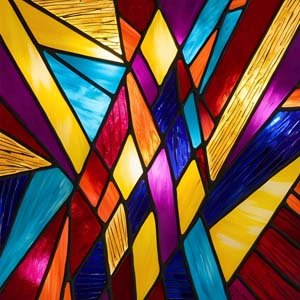
Carl Jung, the Swiss psychiatrist and founder of analytical psychology, believed that each of us is on a journey to become whole. At the heart of his work is a map of the human psyche—a powerful framework for understanding who we are, what drives us, and how we grow.
Below is a simple breakdown of the key elements in Jung’s model of the psyche:
Ego – The Conscious Mind
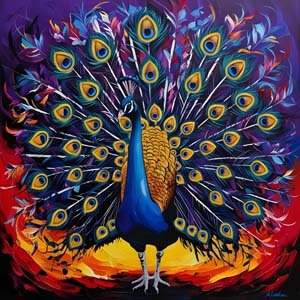
The ego is your sense of identity—your “I.” It’s the part of you that’s aware, makes decisions, and interacts with the world. It includes your thoughts, memories, and perceptions.
Think of it as the center of your conscious experience, but not the whole of who you are.
Example: When you say, “I’m a teacher,” or “I like music,” that’s your ego speaking.
Persona – The Social Mask

The persona is the version of you that you present to others. It’s your public face—the roles you play in society to fit in, be accepted, and function in various environments.
While helpful, the persona can become limiting if you start identifying with it too much and forget there’s more to you beneath the surface.
Example: You might act confident at work, even if you feel unsure inside. That confident mask is your persona.
Shadow – The Hidden Self
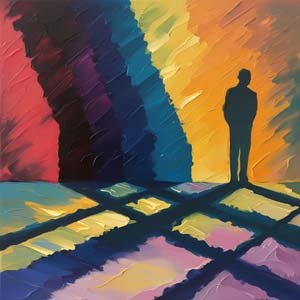
The shadow is made up of the parts of yourself you push away or reject—traits you’ve been taught are “bad,” “unacceptable,” or simply inconvenient. But it also holds positive qualities you’ve ignored or forgotten.
Shadow work means getting honest about your fears, biases, desires, and repressed strengths. Facing your shadow is essential for real inner growth.
Example: If you see yourself as a kind person, your anger might get pushed into the shadow. But that anger can hold power, boundaries, and truth.
Personal Unconscious – The Forgotten and Repressed
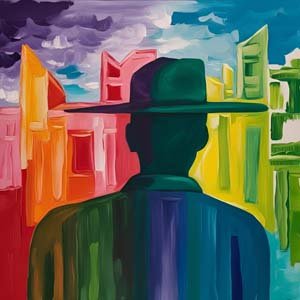
The personal unconscious holds your forgotten memories, emotional wounds, and experiences you’ve pushed out of awareness. It’s unique to you and shaped by your life.
Bringing this hidden material to light helps you grow and gain self-awareness.
Example: You might avoid speaking up because of an old memory of being criticized. That memory lives in your personal unconscious.
Collective Unconscious – The Shared Human Story
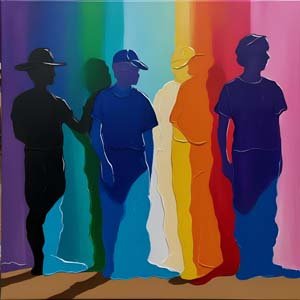
The collective unconscious is a deeper layer of the mind shared by all humans. It contains universal patterns, instincts, and symbols that show up in every culture and every time period.
Carl Jung believed that myths, fairy tales, and dreams speak the language of this unconscious layer.
Example: The hero’s journey found in stories from Star Wars to ancient mythology reflects a universal inner experience.
Archetypes – The Inner Characters

Archetypes are timeless figures and themes living in the collective unconscious. They show up in our dreams, stories, and inner life as familiar characters or energies.
Some core archetypes include:
- The Hero – courage, action, purpose
- The Mother – care, nourishment, or smothering
- The Wise Old Man/Woman – inner guidance and wisdom
- The Trickster – disruption, humor, chaos
- The Shadow – repressed or feared parts of self
- The Anima/Animus – inner feminine/masculine qualities in each person
Archetypes aren’t literal people—they’re symbolic forces within us.
Self – The Whole of Who You Are
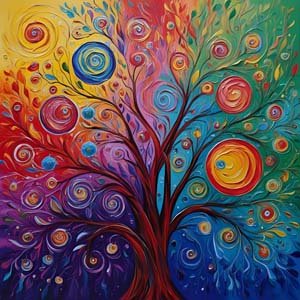
The Self is the center of the entire psyche, both conscious and unconscious. It’s not just who you think you are (ego), but the totality of your being.
Jung saw the Self as the guiding force of inner growth and wholeness. It often reveals itself in dreams or spiritual experiences and points toward your fullest potential.
You could think of the Self as your inner compass, always leading you toward authenticity and balance.
Individuation – The Journey to Wholeness
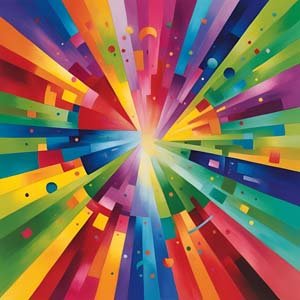
Individuation is the process of becoming your true self. It’s about integrating all parts of you—ego, persona, shadow, and archetypes—into a more conscious, balanced whole.
It doesn’t mean becoming perfect—it means becoming whole. It’s the lifelong path of discovering who you really are beneath the masks, fears, and stories.
Individuation is not a destination, but a journey inward.
Making Sense of the Psyche Through Metaphors
Jung’s ideas are deep and abstract, so metaphors make them easier to relate to. Below are a few that help us visualize the inner world and navigate it with greater clarity.
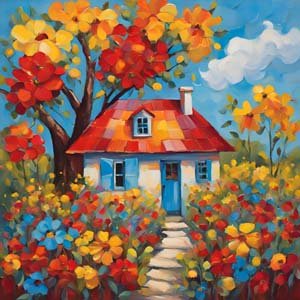
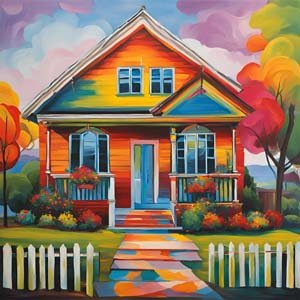
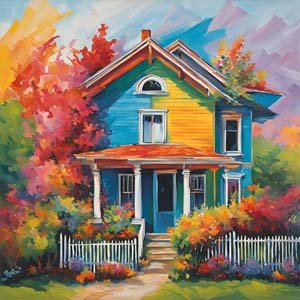
Jung’s model of the psyche can be imagined as a house, with different rooms and hidden spaces representing various aspects of the mind.
Ego (The Main Living Room)
The ego is like the main floor of the house, where you spend most of your time. It’s your conscious self — where you make decisions, interact with guests, and present yourself to the world. It’s the space you control and keep tidy because it’s the part of you that’s most visible.
Persona (The Front Porch & Decor)
The persona is like the front porch, exterior paint, and decorations — what you show to the world. It’s the carefully curated version of yourself, designed to make a good impression. It may not reflect the deeper reality of what’s inside the house, but it helps you function in society.
Shadow (The Locked Basement)
The shadow is like the basement — dark, cluttered, and often avoided. It holds old, forgotten, or unwanted things — suppressed fears, instincts, and emotions. Sometimes, things from the basement creep up unexpectedly, influencing your behavior in ways you don’t fully understand.
Personal Unconscious (The Attic with Old Memories)
The personal unconscious is like the attic, filled with dusty boxes of forgotten experiences, past emotions, and old stories. Some are useful, some are painful, and others are just waiting to be rediscovered. When you dig through the attic, you might find forgotten treasures — or things you’d rather not remember.
Collective Unconscious (The Foundation & Ancestral Blueprints)
The collective unconscious is like the foundation of the house and the original blueprints passed down through generations. Even if you didn’t design the house yourself, it’s built on structures shaped by history, culture, and inherited instincts. It holds universal symbols and experiences common to all humans.
Archetypes (Recurring Architectural Features)
Archetypes are like the repeating patterns in homes — fireplaces, staircases, front doors. Every house (or psyche) has them in some form, but they appear in different styles. These represent universal human experiences—figures like the Wise Old Man (a library), the Nurturing Mother (a cozy kitchen), or the Hero’s Journey (a grand staircase leading upward).
Self (The Entire House and Its Connection to the Land)
The Self is the entire house, including all its rooms, hidden spaces, and even its foundation. It represents the complete, unified you — your conscious identity, hidden depths, and connection to something greater, like the land the house is built on.
Individuation (Renovating & Exploring the Whole House)
Individuation is the process of exploring every room, unlocking the basement, organizing the attic, and making peace with all parts of the house. It’s about truly knowing and accepting your entire home — yourself — so you can live in it fully and authentically, rather than just occupying one or two familiar rooms.
By understanding your whole house, you transform it into a space where you feel at home, rather than lost in hidden rooms or stuck maintaining a perfect front porch.
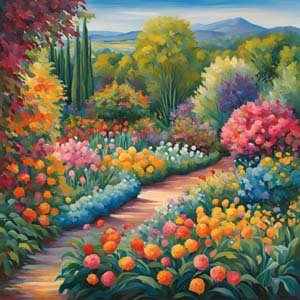

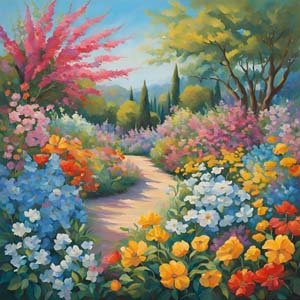
Jung’s model of the psyche can be imagined as a garden, where different elements represent various aspects of the mind.
Ego (The Gardener)
The ego is like the gardener, actively tending to the plants, deciding what to grow, and keeping things orderly. However, the gardener doesn’t control everything — weather, deep roots, and hidden seeds still shape the garden in ways they might not expect.
Persona (The Manicured Front Lawn & Pathways)
The persona is like the well-kept front yard or decorative pathways — the part of the garden meant for public display. It’s carefully arranged to make a good impression, but it doesn’t show everything growing behind the scenes.
Shadow (The Overgrown Weeds & Hidden Corners)
The shadow is like the tangled, overgrown parts of the garden — the wild plants, weeds, and neglected areas. Some of these plants may be unwanted, while others may hold hidden potential. If ignored, they can take over, but if explored, they might contain unexpected beauty or medicinal properties.
Personal Unconscious (The Underground Roots & Forgotten Seeds)
The personal unconscious is like the deep roots, buried seeds, and composting memories of past growth. Some of these roots support the garden’s structure, while others may send up unexpected shoots when the right conditions arise.
Collective Unconscious (The Ancient Soil & Ecosystem)
The collective unconscious is like the rich, ancient soil that has built up over centuries — full of nutrients, history, and patterns that shape all plant life. It holds the wisdom of nature, connecting all gardens across time and space.
Archetypes (The Universal Plants & Seasons)
Archetypes are like the recurring plants and seasonal cycles found in every garden — oak trees of wisdom, roses of love, stormy seasons of transformation. Just as all gardens have sunlight, rain, and growth, all human psyches share common patterns of experience.
Self (The Entire Garden and Its Connection to Nature)
The Self is the entire garden, including the flowers, trees, hidden roots, soil, and the seasons that shape it. It represents the complete, unified you — your conscious mind, unconscious depths, and connection to the cycles of life.
Individuation (Cultivating a Thriving, Balanced Garden)
Individuation is the process of embracing all parts of the garden — taming some wild areas, letting hidden flowers bloom, and accepting both order and chaos. A fully individuated garden is not just a perfect lawn—it is alive, authentic, and full of diverse, interconnected life.
When you achieve individuation, you don’t just control the garden — you coexist with it, understanding its deeper rhythms and allowing all parts of yourself to grow naturally.
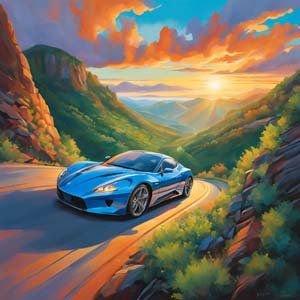


Jung’s model of the psyche can be imagined as a car, where different components represent various aspects of the mind.
Ego (The Driver)
The ego is like the driver of the car — making decisions, steering, and trying to stay on the road. The driver thinks they are in full control, but other forces (hidden mechanics, past experiences, and external conditions) also influence the journey.
Persona (The Car’s Exterior & Dashboard)
The persona is like the polished exterior, brand logo, and dashboard. It’s the part of the car that others see, designed to make a good impression. Just like people choose a car to fit a certain image (luxury, sporty, practical), your persona is the version of yourself you present to the world.
Shadow (The Trunk & Under-the-Hood Mechanics)
The shadow is like the trunk or the engine’s hidden parts — the things you don’t always think about but that influence how the car runs. It might hold tools, old baggage, or even broken parts that you’ve ignored. If neglected, the car might break down or behave unpredictably.
Personal Unconscious (The Glovebox & Rearview Mirror)
The personal unconscious is like the glovebox, where forgotten maps, notes, and objects from past trips are stored. It’s also like the rearview mirror — memories and past experiences that are no longer in immediate focus but still shape how you drive forward.
Collective Unconscious (The Road & Traffic Laws)
The collective unconscious is like the vast road network and traffic laws that all drivers follow, whether they realize it or not. It represents universal human instincts, myths, and inherited knowledge that guide behavior, much like how all drivers instinctively stop at red lights or follow road signs.
Archetypes (The Common Vehicles & Road Signs)
Archetypes are like the universal car models and road symbols everyone recognizes — sports cars for heroes, taxis for guides, stop signs for warnings, detours for unexpected life changes. Every driver encounters them, just as every person encounters archetypal figures in stories and dreams.
Self (The Entire Car and Its Connection to the Road)
The Self is the entire car, including the engine, wheels, dashboard, and even the unseen internal mechanics. It represents the complete, unified you — your conscious mind, unconscious drives, and connection to the journey of life.
Individuation (Mastering the Journey & Driving with Awareness)
Individuation is like learning to drive with full awareness — not just following traffic rules, but understanding your car’s mechanics, embracing its strengths and weaknesses, and enjoying the journey. It means integrating all parts of yourself — the driver, the hidden mechanics, the road ahead, and the past in the rearview mirror — to travel through life with authenticity and purpose.
When individuation is achieved, you don’t just drive blindly — you become fully aware of the vehicle you are in, navigating life’s roads with confidence and self-knowledge.
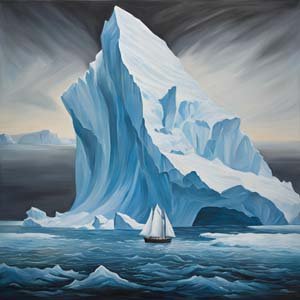
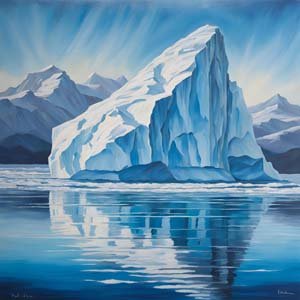
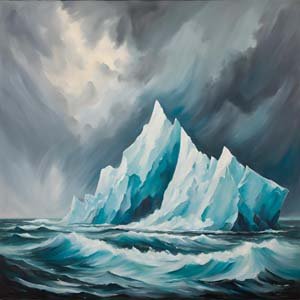
Jung’s model of the psyche can be imagined as an iceberg, where only a small part is visible above the surface, while a vast, hidden structure lies beneath.
Ego (The Tip of the Iceberg)
The ego is the small part of the iceberg above water — your conscious mind, the part of you that thinks, makes decisions, and interacts with the world. It’s what you identify as “me” in daily life.
Persona (The Shiny Ice Coating)
The persona is like a thin layer of polished ice on the tip — what you present to others. It’s shaped by social expectations, helping you fit into different roles (e.g., professional, friend, parent). But it’s not your full self — just a mask.
Shadow (The Dark Crevices Below the Surface)
Just below the water, hidden from view, is the shadow — the parts of yourself you suppress or deny. It holds repressed fears, desires, and aspects you refuse to acknowledge. Sometimes, it surfaces unexpectedly in emotions, projections, or conflicts.
Personal Unconscious (The Ice Just Below the Waves)
This is where forgotten experiences, memories, and emotions reside — still personal but outside of immediate awareness. Like the submerged ice near the surface, it can rise up when triggered by dreams, emotions, or deep reflection.
Collective Unconscious (The Massive Ice Foundation in the Depths)
Deep below, forming the very foundation of the iceberg, is the collective unconscious — a vast, inherited part of the psyche that connects all humans. It holds universal symbols, instincts, and patterns of thought, much like deep-sea currents that shape ice formations over millennia.
Archetypes (The Hidden Ice Structures Underneath)
Within the collective unconscious are archetypes — recurring patterns or universal figures (the Hero, the Wise Old Man, the Mother). These are like mysterious formations shaping the iceberg’s unseen mass, influencing myths, dreams, and personal growth.
Self (The Whole Iceberg and Its Connection to the Ocean)
The Self is the entire iceberg, both the visible tip and the vast hidden mass below, fully connected to the surrounding ocean. It represents the complete, unified you — conscious and unconscious, personal and collective.
Individuation (The Iceberg Rising to the Sun)
Individuation is the process of integrating all parts of the psyche — ego, shadow, persona, unconscious — into a balanced whole. It’s like the iceberg slowly rising and melting into the sunlight, revealing its hidden depths and becoming fully known to itself.
When individuation is achieved, the iceberg is no longer just a disconnected floating mass but a fully realized structure, harmonizing with the depths below and the surface above. The self becomes authentic, rich, and whole — not just a fragmented identity, but a masterpiece of self-awareness and unity.
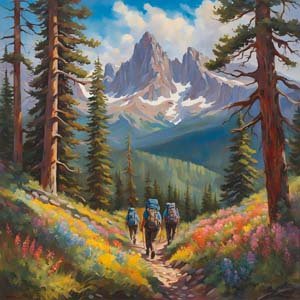
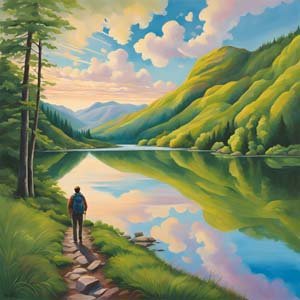
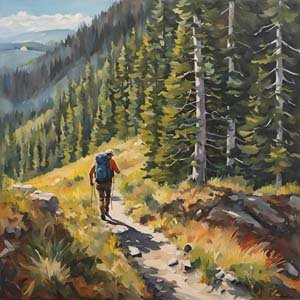
Jung’s model of the psyche can be imagined as a hiking journey, where different elements represent various aspects of the mind.
Ego (The Hiker on the Trail)
The ego is like the hiker — choosing the path, making decisions, and navigating the terrain. The hiker believes they are in control, but the landscape, weather, and unseen obstacles also shape the journey.
Persona (The Gear & Outfit Chosen for the Hike)
The persona is like the hiking gear, clothing, and backpack the hiker wears — selected to present a certain image or fit into the environment. Just as hikers might wear high-tech gear to appear experienced, people craft their personas to be accepted by society.
Shadow (The Hidden, Unexplored Trails & Fears)
The shadow is like the unmarked paths, deep ravines, and dark forests the hiker avoids. These areas may seem dangerous or undesirable, but they might also hold hidden beauty, shortcuts, or personal growth if explored with courage.
Personal Unconscious (The Map of Past Trails & Old Footprints)
The personal unconscious is like the footprints left behind on previous hikes — the memories, struggles, and lessons from past journeys. Some trails were pleasant, others difficult, but they all influence how the hiker approaches the next climb.
Collective Unconscious (The Vast Mountain Range & Natural Laws)
The collective unconscious is like the vast mountain range itself — ancient, shared by all, and governed by universal forces like gravity, weather, and seasons. Every hiker, no matter where they come from, must face these same fundamental realities.
Archetypes (The Universal Plants & Seasons)
Archetypes are like the recurring plants and seasonal cycles found in every garden — oak trees of wisdom, roses of love, stormy seasons of transformation. Just as all gardens have sunlight, rain, and growth, all human psyches share common patterns of experience.
Self (The Hiker and the Entire Journey)
The Self is the hiker and the entire hiking experience, including the trail, the mountain, the hidden valleys, and even the unseen forces like the weather and terrain. It represents the complete, unified you — your conscious awareness, unconscious depths, and connection to the greater path of life.
Individuation (Reaching the Summit & Becoming One with the Journey)
Individuation is like reaching a breathtaking mountain peak — not just conquering the hike, but understanding the journey, embracing the challenges, and feeling at peace with the entire landscape. A fully individuated hiker learns that the journey itself is just as important as the destination.
When individuation is achieved, the hiker no longer fears the dark valleys or avoids the steep climbs — they walk the path with awareness, strength, and a deep connection to the mountains within.
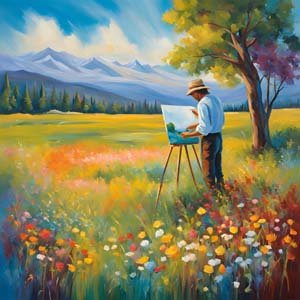
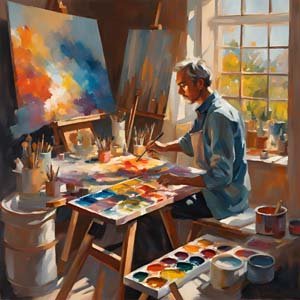
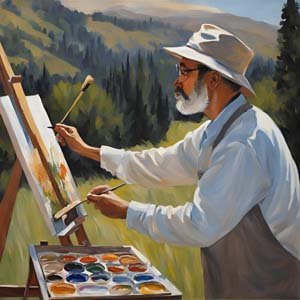
Jung’s model of the psyche can be imagined as a painter creating a masterpiece, where every brushstroke, color choice, and hidden layer represents different aspects of the mind.
Ego (The Painter’s Conscious Brushstrokes)
The ego is the painter’s active brushstrokes — the choices they make, what they focus on, and how they see themselves in the moment. It’s their conscious awareness, shaping how they present their work to the world.
Persona (The Publicly Displayed Painting)
The persona is the version of the painting shown in a gallery — polished, framed, and adjusted to fit expectations. It’s the mask the painter wears, crafted to be accepted and admired by others.
Shadow (The Dark, Rejected Paint Strokes)
The shadow is the part of the painting the artist tries to cover up — the mistakes, unintended marks, or elements they don’t want to acknowledge. Yet, these hidden strokes add depth and meaning to the final work.
Personal Unconscious (The Hidden Layers Beneath the Paint)
The personal unconscious is like the underpainting — past mistakes, faded sketches, and old brushstrokes buried beneath the surface. Though no longer visible, these layers influence the final image.
Collective Unconscious (The Universal Colors and Forms All Artists Use)
The collective unconscious is the universal color palette and artistic principles shared by all painters. It holds deep, inherited symbols and themes that have shaped human creativity across time.
Archetypes (The Timeless Symbols in Every Masterpiece)
Archetypes are the recurring themes and symbols found in art throughout history — the hero, the mother, the storm before renewal. They are patterns that appear in every great painting, just as they appear in the human psyche.
Self (The Complete Masterpiece and the Artist’s True Vision)
The Self is the finished masterpiece — the full painting in all its depth, beauty, and complexity. It is the painter’s true vision, embracing both light and shadow, conscious intention and hidden depth.
Individuation (Becoming a True Master of the Art)
Individuation is like the painter mastering their craft — no longer afraid of mistakes, hidden layers, or unconventional strokes.
When individuation is achieved, the painting is no longer just a collection of brushstrokes but a masterpiece of self-awareness, authenticity, and artistic truth.
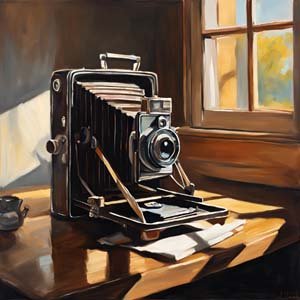

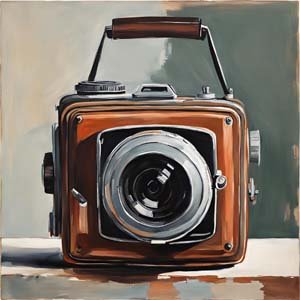
Jung’s model of the psyche can be imagined as a camera, where different components represent various aspects of the mind.
Ego (The Photographer Looking Through the Lens)
The ego is like the photographer — choosing what to focus on, adjusting the settings, and framing the shot. The photographer believes they are in full control, but their vision is shaped by the camera, lighting, and subconscious influences.
Persona (The Edited & Filtered Photo for the Public)
The persona is like the final, edited image that is shared with the world. It is carefully cropped, filtered, and adjusted to present a certain version of reality. Just as a photographer chooses how they want their image to appear, people craft their personas to be socially accepted.
Shadow (The Unseen & Rejected Images in the Camera Roll)
The shadow is like the outtakes, blurred shots, and unflattering photos hidden in the camera roll. These are the images the photographer doesn’t want others to see but are still part of the full picture. If ignored, they may resurface in unexpected ways.
Personal Unconscious (The Camera’s Memory Card of Forgotten Shots)
The personal unconscious is like the memory card, storing thousands of past images — some remembered, some buried deep in old folders. These past snapshots influence how the photographer sees and captures new images, even if they aren’t consciously thinking about them.
Collective Unconscious (The Universal Rules of Light & Composition)
The collective unconscious is like the fundamental principles of photography — light, shadow, composition, and perspective—that all photographers rely on. These are not invented but inherited, shaping how all humans perceive and capture the world.
Archetypes (The Iconic Shots & Timeless Compositions)
Archetypes are like the classic shots that appear across all cultures — silhouettes at sunset, the hero’s determined gaze, the mother cradling a child. These universal themes appear in photography just as they do in myths, dreams, and human experiences.
Self (The Photographer and the Entire Camera System)
The Self is the photographer and the entire camera, including the lens, shutter, memory card, and even the light that shapes the image. It represents the complete, unified you — your conscious awareness, unconscious influences, and connection to the greater picture of life.
Individuation (Mastering the Art of Seeing Clearly)
Individuation is like becoming a true photographer — learning to see beyond the obvious, embracing all aspects of light and shadow, and capturing the full depth of reality. A fully individuated photographer does not just take pretty pictures but sees the world with clarity, honesty, and artistic truth.
When individuation is achieved, the photographer no longer hides from the imperfect shots—they embrace every image, knowing that light and shadow together create the full picture.

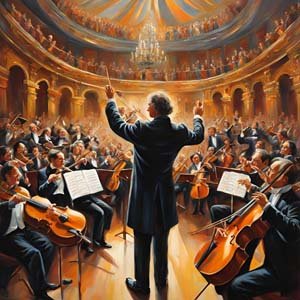

Jung’s model of the psyche can be imagined as an orchestra, where different instruments and sections represent various aspects of the mind.
Ego (The Conductor)
The ego is like the conductor of the orchestra — actively directing the performance, making decisions, and trying to create harmony. However, the conductor doesn’t create the music alone; they must work with the entire ensemble, including parts they don’t fully control.
Persona (The Public Performance & Stage Presence)
The persona is like the polished performance an audience sees. The orchestra wears formal attire, follows social expectations, and presents a refined version of itself. This is the public face you show to the world, but it doesn’t reveal all the behind-the-scenes work.
Shadow (The Untuned or Hidden Instruments)
The shadow is like the instruments that are out of tune, ignored, or left in the back of the orchestra. These might be dissonant, but they are still part of the music. If neglected, they may disrupt the performance in unexpected ways — just like suppressed emotions or hidden traits can unexpectedly surface in life.
Personal Unconscious (The Forgotten Sheet Music & Old Melodies)
The personal unconscious is like a collection of old sheet music and forgotten melodies stored in the archives. These are personal experiences, memories, and emotions that aren’t in your daily awareness but still shape the way you play your music.
Collective Unconscious (The Deep Traditions & Universal Rhythms)
The collective unconscious is like the deep traditions of music — universal rhythms, harmonies, and structures that exist across cultures and time. Just as all music follows certain patterns (like scales or chord progressions), human psychology follows inherited patterns of thought, feeling, and storytelling.
Archetypes (The Timeless Musical Themes & Instruments)
Archetypes are like the recurring musical themes and essential instruments in every orchestra. Every culture has its Hero’s Theme (triumphant trumpets), Wise Old Mentor (deep cellos), or Trickster (playful flutes). These patterns appear in myths, dreams, and human experiences across time.
Self (The Entire Orchestra and Its Harmony with Music)
The Self is the entire orchestra, including every instrument, musician, and the music itself. It represents the complete, unified you — your conscious mind, hidden depths, and connection to a greater harmony beyond yourself.
Individuation (Mastering the Symphony & Finding True Harmony)
Individuation is the process of integrating all instruments — learning to balance the loud and soft, the bright and dark, the controlled and the chaotic. It’s about recognizing every part of the orchestra, even the ones you ignored, and allowing the full self to play in harmony.
When individuation is achieved, the music becomes authentic, rich, and whole — not just a collection of separate sounds but a masterpiece of self-awareness and expression.
Postlude

The Jungian psyche shows us that we are more than our thoughts or surface behaviors.
Beneath the everyday self lies a rich, complex inner world—and by exploring it, we can grow into our full, authentic potential.
Which part of the psyche feels most active or relevant in your life right now—and what might it be trying to show you about your journey toward wholeness?
